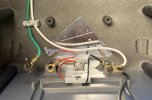Good morning fellow G Enthusiasts!
I am repairing some crappy OEM Aristo-Craft wiring. I want to stock up on the terminals and wire used. (I have been using wire from old computers)
 Can someone please tell me what size the round eye terminals are and what size/gauge wire that they use? Thanks.
Can someone please tell me what size the round eye terminals are and what size/gauge wire that they use? Thanks.
Enjoy your trains as much as possible! AJ the Teacher
I am repairing some crappy OEM Aristo-Craft wiring. I want to stock up on the terminals and wire used. (I have been using wire from old computers)
 Can someone please tell me what size the round eye terminals are and what size/gauge wire that they use? Thanks.
Can someone please tell me what size the round eye terminals are and what size/gauge wire that they use? Thanks. Enjoy your trains as much as possible! AJ the Teacher

